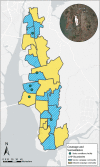Programmatic Effectiveness of a Pediatric Typhoid Conjugate Vaccine Campaign in Navi Mumbai, India
- PMID: 36947143
- PMCID: PMC10320126
- DOI: 10.1093/cid/ciad132
Programmatic Effectiveness of a Pediatric Typhoid Conjugate Vaccine Campaign in Navi Mumbai, India
Abstract
Background: The World Health Organization recommends vaccines for prevention and control of typhoid fever, especially where antimicrobial-resistant typhoid circulates. In 2018, the Navi Mumbai Municipal Corporation (NMMC) implemented a typhoid conjugate vaccine (TCV) campaign. The campaign targeted all children aged 9 months through 14 years within NMMC boundaries (approximately 320 000 children) over 2 vaccination phases. The phase 1 campaign occurred from 14 July 2018 through 25 August 2018 (71% coverage, approximately 113 420 children). We evaluated the phase 1 campaign's programmatic effectiveness in reducing typhoid cases at the community level.
Methods: We established prospective, blood culture-based surveillance at 6 hospitals in Navi Mumbai and offered blood cultures to children who presented with fever ≥3 days. We used a cluster-randomized (by administrative boundary) test-negative design to estimate the effectiveness of the vaccination campaign on pediatric typhoid cases. We matched test-positive, culture-confirmed typhoid cases with up to 3 test-negative, culture-negative controls by age and date of blood culture and assessed community vaccine campaign phase as an exposure using conditional logistic regression.
Results: Between 1 September 2018 and 31 March 2021, we identified 81 typhoid cases and matched these with 238 controls. Cases were 0.44 times as likely to live in vaccine campaign communities (programmatic effectiveness, 56%; 95% confidence interval [CI], 25% to 74%; P = .002). Cases aged ≥5 years were 0.37 times as likely (95% CI, .19 to .70; P = .002) and cases during the first year of surveillance were 0.30 times as likely (95% CI, .14 to .64; P = .002) to live in vaccine campaign communities.
Conclusions: Our findings support the use of TCV mass vaccination campaigns as effective population-based tools to combat typhoid fever.
Keywords: Salmonella Typhi; India; global health; typhoid fever; vaccines.
© The Author(s) 2023. Published by Oxford University Press on behalf of Infectious Diseases Society of America.
Conflict of interest statement
Potential conflicts of interest. K. D. reports support for attending meetings and/or travel by their employer (the CDC). S. P. L. reports support for attending meetings and/or travel from the Bill & Melinda Gates Foundation (conferences where some of the work from this project were reported). All other authors report no potential conflicts. All authors have submitted the ICMJE Form for Disclosure of Potential Conflicts of Interest. Conflicts that the editors consider relevant to the content of the manuscript have been disclosed.
Figures


Comment in
-
Gateway to Typhoid Conjugate Vaccine Introduction in India and Beyond-Programmatic Effectiveness of a Public Sector Typhoid Conjugate Vaccine Campaign in Navi Mumbai.Clin Infect Dis. 2023 Jul 5;77(1):145-147. doi: 10.1093/cid/ciad134. Clin Infect Dis. 2023. PMID: 36947122 Free PMC article. No abstract available.
References
-
- Woodward TE, Smadel JE. Management of typhoid fever and its complications. Ann Intern Med 1964; 60:144–57. - PubMed
-
- Marmion DE. The treatment of typhoid fever with chloramphenicol; a clinical study of 330 cases of enteric fever treated in Egypt. Trans R Soc Trop Med Hyg 1952; 46:619–38. - PubMed
-
- Woodward TE, Smadel JE, Parker RT, WissemanCL, Jr. Treatment of typhoid fever with antibiotics. Ann N Y Acad Sci 1952; 55:1043–55. - PubMed

